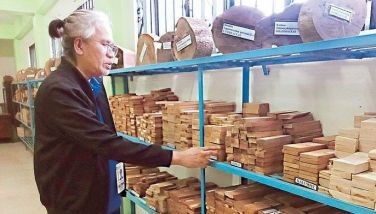P400 million withdrawn from CAAP funds by Arroyo government - union
MANILA, Philippines - More than P400 million in massive withdrawals by the Civil Aviation Authority of the Philippines (CAAP) in the last months of the previous administration could have been patterned after the “pabaon” system of the Armed Forces of the Philippines (AFP).
The CAAP Employees Union (CAAP-EU) urged the Senate to investigate several withdrawals made by former CAAP director general Ruben Ciron.
The union claimed Ciron made massive withdrawals, assisted by his chief of staff Ronaldo Manlapig, in March 2010.
The withdrawals were made before Ciron was replaced by Alfonso Cusi, then general manager of the Manila International Airport Authority (MIAA).
Cusi’s appointment to the CAAP was among the many midnight appointments made by former President Gloria Macapagal-Arroyo in the last months of her administration, the union pointed out.
It was learned that Ciron was a former Air Force general who served in various posts at the Department of National Defense, before he was appointed by Arroyo to head the then newly created CAAP in 2008.
Ciron is a member of the Philippine Military Academy (PMA) Class of 1968.
The CAAP-EU reportedly obtained a copy of the CAAP’s account with the United Coconut Planters Bank (UCPB) and the Land Bank of the Philippines that showed five huge cash withdrawals shortly before Ciron’s departure as head of CAAP in March 2010.
From the data seen in CAAP’s passbook with the UCPB, which figured in the AFP “conversion” scandal, the CAAP withdrew P150 million on Jan. 7 and P80 million on March 2, last year.
The Landbank passbook, on the other hand, showed there were four huge US dollar withdrawals made by the CAAP in a two-week period last year from the government bank – US$1 million on Feb. 23, another US$1 million on Feb. 26, and US$2 million, also on March 2.
“These withdrawals are highly questionable since it was made when he was known to be on the way out due to the CAAP’s failures such as the issuance of the SSC (significance safety concerns) findings on Philippine civil aviation by the ICAO (International Civil Aviation Organization) in December 2009 and the Category II downgrade of the Philippines by the US FAA (United States Federal Aviation Authority,” a CAAP-EU official said.
Apart from the huge bank withdrawals, the CAAP-EU said another anomaly in the CAAP that seemed similar to the AFP “conversion” controversy was the disbursements of United Nations fund, noting the ICAO was a specialized agency of the UN on international civil aviation matters.
It was learned that the Commission on Audit (COA), in their 2009 audit of the agency, had discovered that the CAAP’s ICAO trust fund which was deposited with up to US$12 million from its establishment in 1996, had been depleted to a degree that it has a standing balance of only US$3 million as of end 2009.
The spending of the US$9 million would be hard to justify, considering the SSC finding on the Philippines in 2009 by the ICAO USOAP audit, the union said.
The union earlier exposed the issuance of the SSC by the ICAO during their call for the ouster of Ciron from the agency.
The CAAP-EU revealed in January 2010 of the ICAO’s inclusion of the Philippines in a list of countries they found with “significant safety concern” on its civil aviation systems after their conduct of inspections under their Universal Safety Oversight Audit Program (USOAP) in 2009.
In an electronic bulletin issued by the ICAO on Dec. 18, 2009 the ICAO listed the countries with SSC findings as Angola, Bangladesh, Cambodia, Congo, Djibouti, Guinea-Bissau, Kazakhstan, Malawi, Philippines, Rwanda, and Zambia.
“The safety oversight audit of the Philippines under the comprehensive systems approach revealed a Significant Safety Concern which remains unresolved by the State,” the ICAO said.
The SSC finding for the Philippines was a double whammy for the country’s local civil aviation industry after the US Federal Aviation Authority downgraded the country from a Category I to a Category II rating due to deficiencies in its civil aviation systems in December 2007.
The FAA downgrade caused the Arroyo government to rush legislation of Republic Act 9497 which created the CAAP from its forerunner, the Air Transportation Office (ATO), since it turned it into an “authority” with autonomy, empowering it to keep the billions in income it raises from the collection of landing and navigation fees to buy vital equipment and hire qualified technical personnel by raising salaries to international standards.
The CAAP-EU, through its vice-president Cesar Lucero, laid the blame for the failures of CAAP on Ciron, who he claimed had mainly attended to the hiring of his fellow retired military officers and members in the Reform the Armed Forces of the Philippines (RAM) into vital and highly technical positions at the CAAP as “consultants” even without having civil aviation experience and expertise.
Worse, Lucero said, these consultants were being appointed by Ciron to head plantilla positions that were not allowed by civil service laws.
The union stressed that under RA 9497, the CAAP was supposed to absorb the regular employees of the agency’s forerunner, the ATO, in order to retain the experienced air traffic controllers and other crucial technical employees of the agency.
- Latest
- Trending





























